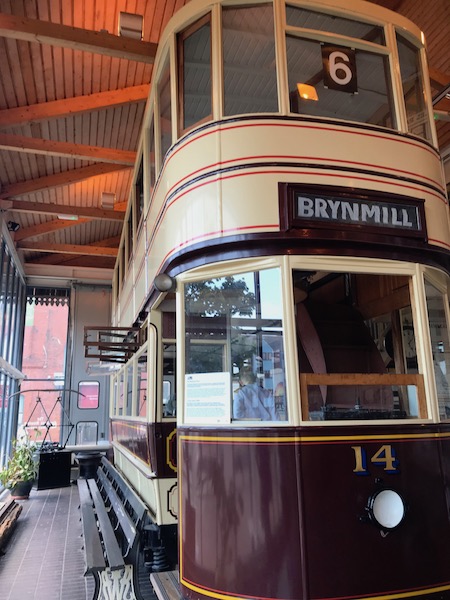Our Blog - Swansea, Wales
When we were playing golf at Gower, we met a nice couple who were playing behind us and they mentioned that Swansea was not that great of a place ... "a dump" I believe was their exact term. Mind you, we didn't find it a dump, but it wasn't the best place either. It is the 2nd largest city (after Cardiff) in Wales and also sits on the water. During its 19th-century industrial hey-day, Swansea was a key center of the copper industry, earning the nickname Copperopolis. The port of Swansea initially traded in wine, hides, wool, cloth and later in coal. With all of the heavy industry in the city, it had economic importance. While that is normally good, it wasn't so good during the Second World War as it made Swansea the target of German bombing, and much of the town center was destroyed during the Swansea Blitz on the 19, 20 and 21 February 1941.
A major claim-to-fame for Swansea is the poet, Dylan Thomas. I never knew much about Dylan Thomas ... my only real knowledge was from the Michelle Pfeiffer movie, Dangerous Minds, where she plays a retired Marine turned teacher of high-risk students. In order to introduce them to poetry, she uses the lyrics of Bob Dylan's "Mr. Tambourine Man" to teach symbolism and metaphor and once this is achieved, she progresses on to Dylan Thomas's "Do not go gentle into that good night". Anyway, Dylan Thomas was born and raised here, producing 2/3 of his published works from a bedrooms in one of the Swansea suburbs. Another piece of trivia: Swansea's most famous daughter is Hollywood actress Catherine Zeta-Jones who still owns a home in Mumbles.
It seems that Chitty Chitty Bang Bang, the Musical was coming to Swansea and so they had the car on display in the center of town when we were walking around. We didn't know it was going to be there, but we grabbed a few pics anyway.


Like almost every town, Swansea has a Castle. The first timber castle was built around 1106 and the ruins that are visible now is small part of the last castle from the late 13th century. The castle suffered in many Welsh raids and changed hands many times. Only the North and South blocks remain (well, kinda remain). The south block is the best preserved and has an arcaded parapet on top of the outside walls. Two large windows on the south side are the windows of the first-floor hall, and below them are the narrow windows of three barrel-vaulted chambers. At the west end of the block is a spectacular circular garderobe tower standing to its full height, and in the south-east angle is a small turret with an arrow slit.







There was a church on the site of St Mary's Collegiate and Parish Church since around 1328. The roof collapsed in 1739 and the entire church was rebuilt (except for the tower). It was rebuilt again in 1896 and then again in the 1950s after being extensively damaged by bombing during World War II.




Dylan Thomas Square is in the Maritime Quarter and a bronze statue of the Welsh poet is located in the square. On one side of the square sits the Pump House, which is a good representation of Victorian architecture in Swansea. Its original purpose was to serve as a pumping station, but it changed through the years and is now a pub (which we ate lunch at).

In the famous Dylan Thomas radio play "Under Milk Wood", the blind old sea captain, known as Captain Cat, is one of the play's most important characters. There is a statue of Captain Cat by Robert Thomas standing across from the Pump House at Dylan Thomas Square.

We went into the Swansea Museum for a few minutes, but they also have 3 boats (the Lightship Helwick, the Tug boat Canning, and 1909 Bristol Channel Pilot Cutter Olga) moored at the port.


There is also a Swansea Museum Tramway Center, which displays replicas of some early Railway carriages that were used in the Mumbles Railway. There is also a restored double-decker tram that was typical of what was used on the tram system. There were also single-decker cars due to the number of railway bridges. The system was closed in 1937. The last picture shows a picture of a double-decker tram on Oxford Street in 1909.



This Gnoll Stone is part of a Celtic wheel cross carved during the 11th century. It shows a Celtic priest wearing a short, pleated kilt. He has his hands raised in prayer.

Describing itself as Swansea's only boutique hotel, the Morgans Hotel is the only Welsh Tourist Board 5 star hotel in Swansea (although only a 4-star hotel international standards). Originally completed in 1903, the main hotel building was originally offices of the British Ports and the original character of the building was preserved when it was changed into a hotel. The decorative Baroque exterior in red brick and white stone is topped by a Greek statue-clad clock cupola. The interior features stained glass with compasses, exploration and maritime themes. A mural depicting tall-mast ships on the River Tawe, overlooked by Swansea Castle, decorates the boardroom.

Continue to Day 14: Porthcawl or go back to the main Wales vacation blog page